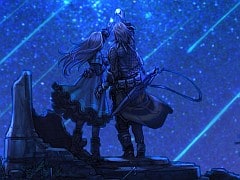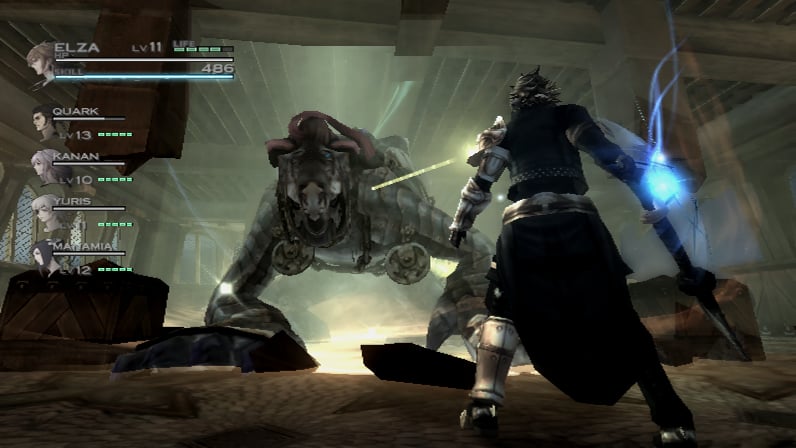You can trust VideoGamer. Our team of gaming experts spend hours testing and reviewing the latest games, to ensure you're reading the most comprehensive guide possible. Rest assured, all imagery and advice is unique and original. Check out how we test and review games here
Some critics would have you believe that the JRPG is stagnating into irrelevance, but recent entries show a genre in rude health, as developers consistently experiment with the form. Atlus’s Radiant Historia offered several finely-tuned twists on established standards, while tri-Ace’s inventive – if overlong – Resonance of Fate toyed with unusual structure and combat systems to promising effect. And whatever you think of Final Fantasy XIII and its follow-up, you certainly can’t accuse Square Enix of being unwilling to change.
Best of the recent bunch, however, was Monolith Soft’s Xenoblade Chronicles, a beautiful sprawl of an RPG set in a mesmeric world and bolstered by fine combat mechanics. Challenging Skyward Sword for the best Wii game of last year, it left a tough act for any JRPG to follow. That The Last Story doesn’t quite match up isn’t much of a criticism; few games could. That it comes close is a laudable achievement.
After an action-packed opening, the pace slows, allowing the player time to get to know protagonist Zael and the group of mercenaries he journeys with. Congregating at a bar, the band talk and drink, and quests are low-key missions. Though events inevitably escalate, these are telling moments in an adventure that feels more intimate than many of its peers. By narrowing the scope, Sakaguchi quickly brings us into the bosom of this likeable band, and there’s comforting warmth to the early exchanges.
Then the ante is upped as the game progresses in short episodes that maintain a strong sense of forward momentum. Across the first half-dozen of these, the game’s battle systems are sensibly drip-fed. At first it’s all fairly simple real-time action: push the analogue stick in any direction when you’re close to an enemy and Zael will swing his sword accordingly. To maximise your attack effectiveness, however, you’ll need to get behind enemies to deal extra damage, or better still, attack them unawares. The best way to do this is to hide behind walls or pillars and isolate a single enemy by luring it over with an arrow. As it inquisitively approaches, you can leap out of cover and take it down with a powerful slash. Fools can still rush in, of course, but you then stand the risk of being surrounded, at which point you’ll take more damage from every hit. The piecemeal approach is the way to go, then, and it’s much more satisfying to deal with a large group in such a sleek, efficient manner rather than a messy cavalry charge.
Meanwhile, Zael’s Gathering power allows him to revive downed allies, at the cost of attracting enemy attention. It’s a risky strategy in one sense, but by drawing attackers away from your magic user, you can give them the space to cast a magic circle, which you can stand inside to heal or imbue your attacks with elemental buffs. Then there’s the Gale ability, which pauses the action, switching to an overhead perspective so you can diffuse magic circles to heal all team members or damage multiple enemies. Later, the top-down view gives you access to a command system if you need to issue more specific instructions, though you can also do this in real-time on occasion, marking weakened masonry and asking your magic user to bring it down onto larger or grouped enemies.
Every battle feels like a set-piece of sorts. Naturally, some are bigger and more dramatic than others, but it offers a variety of skirmishes: one minute you’ll be fighting a large number of small enemies in an open-plan environment, the next you’ll battle a large boss in the confines of a small room. Sometimes you’ll need to use stealth to stop low-level characters alerting others; then you’ll have a one-on-one swordfight. The character roster doesn’t change a great deal – you’ll get a few new additions to the team but in the main they’re chosen from the same squad – but the party size and makeup changes regularly, forcing you to mix up your approach and to really learn the intricacies of the battle system to get by.
At least, that’s the theory. But as you get five lives per character per encounter, it doesn’t really matter if you don’t really get into the swing of things, because you’ve enough of a safety net to muddle through. AI allies are extremely efficient, and on the occasions they do fall, you can just activate Gathering mode and revive them. All this is helpful when you’re learning the ropes, but it rather smoothes off the difficulty curve once you’ve mastered the most effective tactics.
Still, the dynamism of the system and the drama provided by Nobuo Uematsu’s excellent score makes for some pulsating encounters, and the ability to summon more enemies to fight at special portals offers the opportunity to get some practice and experience without the need to find suitable areas for grinding. It helps that each battle has its own scripted dialogue rather than the same stock phrases repeated ad infinitum. Xenoblade’s “what a bunch of jokers” got a bit much by hour five, let alone 50, but you won’t get fed up of the dialogue here.
Indeed, that’s true of the entire localisation. Nintendo of Europe has excelled itself in the translation effort, and as with Xenoblade, regional UK accents dominate. The Mancunian twang of flirty drunkard Syrenne is a particular delight, while softly-spoken Scot Lowell is equally likeable. You’ll hear Essex girl landladies and Irish guards, though once again, the bad guys are almost exclusively Londoners. The script, meanwhile, is filled with colloquialisms and phrases that clearly weren’t in the Japanese original. Attempt to peek in on Syrenne in the tub and she angrily admonishes you – “yer big perv!” – though it’s worth resisting the basest of urges in this instance for a double-entendre-laden exchange.
Yet the warmth, wit and charm of the dialogue and voice acting serves a story that, ignoring the atypically brisk pace, reverts to JRPG archetype. There’s the orphaned hero, the ragtag band of mercenaries with hearts of gold, the mysterious girl with a secret identity and even more secret powers – and a bad guy who’s been taking fashion and grooming tips from Ganondorf. For a game that’s so fiercely inventive elsewhere to fall back on such a rote RPG setup is disappointing. Perhaps it’s churlish to complain about a concept that has long been a genre staple, but the clichéd world-saving plot sits uneasily with the creativity elsewhere.
That includes a level of customisation rare in JRPGs, so you can not only deck out your gang in a variety of different gear but also change the colour of their outfits. Your clothing choices carry over into the cutscenes which, in another sop to accessibility, can be fast-forwarded. It’s a game in a bit of a hurry, alright, and such briskness extends to its runtime, which for most players will be around the 20-hour mark. Sadly, that pace doesn’t carry over to the sometimes sluggish framerate: explore the busy Lazulis city that acts as a hub during the early game and it chugs badly, though it’s less of an issue during combat. Otherwise, it’s technically solid, if a little too fond of bloom lighting and the colour brown, and can’t compare with the scale and vibrancy of Xenoblade’s world of wonder.
Although it can’t quite live up to Monolith’s last astonishing reinvention of the JRPG, The Last Story offers highlights of its own. Full of gags, bawdy humour and pratfalls (what other game gives you the chance to shoot bananas at the feet of citizens for comic relief?) it’s got charm to spare. Unlike Sakaguchi’s biggest hit, The Last Story’s title is more likely to be a self-fulfilling prophecy, but it represents compelling proof that there’s still life in the old JRPG yet.

/https://oimg.videogamer.com/images/0657/the_last_story_19.jpg)






